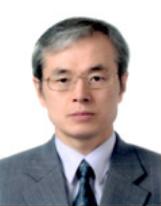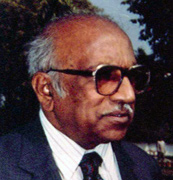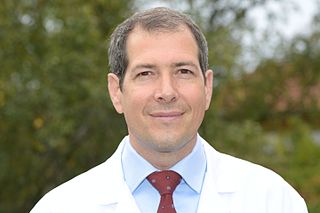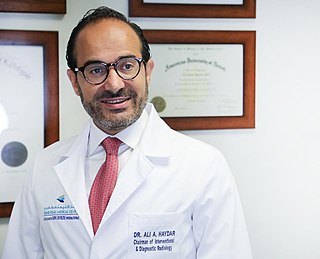Related Research Articles

Radiology is the medical discipline that uses medical imaging to diagnose diseases and guide their treatment, within the bodies of humans and other animals. It began with radiography, but today it includes all imaging modalities, including those that use no electromagnetic radiation, as well as others that do, such as computed tomography (CT), fluoroscopy, and nuclear medicine including positron emission tomography (PET). Interventional radiology is the performance of usually minimally invasive medical procedures with the guidance of imaging technologies such as those mentioned above.

A thoracic aortic aneurysm is an aortic aneurysm that presents primarily in the thorax.

Carotid artery stenosis is a narrowing or constriction of any part of the carotid arteries, usually caused by atherosclerosis.

The European Society of Cardiology (ESC) is an independent non-profit, non-governmental professional association that works to advance the prevention, diagnosis and management of diseases of the heart and blood vessels, and improve scientific understanding of the heart and vascular system. This is done by:
Andrew Nicolaides is a British-Greek Cypriot surgeon, and an expert in cardiovascular disease and stroke prevention.

CardioVascular and Interventional Radiology is a peer-reviewed medical journal published by Springer. It is the journal of the Cardiovascular and Interventional Radiological Society of Europe.
The Society of Interventional Radiology (SIR) is an American national organization of physicians, scientists and allied health professionals dedicated to improving public health through the use of minimally invasive, image-guided therapeutic interventions for disease management.
The European Association for Cardio-Thoracic Surgery (EACTS) is a membership organisation devoted to the practice of cardiothoracic surgery. The mission statement of the association is to advance education in the field of cardiac, thoracic and vascular interventions; and promote research into cardiovascular and thoracic physiology, pathology and therapy, with the aim to correlate and disseminate the results for the public benefit. Within the EACTS there is a large number of committees working on various issues in order to improve cardio-thoracic surgery.

Park Seung-jung is a South Korean cardiologist. Currently he is chairman of the Heart Institute at Asan Medical Center in Seoul and professor of medicine at University of Ulsan.

Song Ho-young is a South Korean radiologist. He studied at the Chonbuk National University and now works at the Asan Medical Center. He is the founder of the Society of Gastrointestinal Intervention (SGI).
Interventional oncology is a subspecialty field of interventional radiology that deals with the diagnosis and treatment of cancer and cancer-related problems using targeted minimally invasive procedures performed under image guidance. Interventional oncology has developed to a separate pillar of modern oncology and it employs X-ray, ultrasound, computed tomography (CT) or magnetic resonance imaging (MRI) to help guide miniaturized instruments to allow targeted and precise treatment of solid tumours located in various organs of the human body, including but not limited to the liver, kidneys, lungs, and bones. Interventional oncology treatments are routinely carried out by interventional radiologists in appropriate settings and facilities.

Nagarur Gopinath was an Indian surgeon and one of the pioneers of cardiothoracic surgery in India. He is credited with the first successful performance of open heart surgery in India which he performed in 1962. He served as the honorary surgeon to two Presidents of India and was a recipient of the fourth highest Indian civilian award of Padma Shri in 1974 and Dr. B. C. Roy Award, the highest Indian medical award in 1978 from the Government of India.

Christoph Huber MD, FMH, FECTS is a Swiss cardiac surgeon who is a professor and the head of the Division of Cardiac and Vascular Surgery at the University Hospital Geneva, Switzerland.
Renate L. Soulen, MD, FSIR is an American physician. She is credited as one of three women co-founders of the Society for CardioVascular and Interventional Radiology, a founding member of the Philadelphia Angio Club, and the first female president of the Philadelphia Roentgen Ray Society.
Anna-Maria Belli, MD, FCIRSE is a British interventional radiologist known for her work in vascular interventional radiology and for holding leadership positions in interventional radiology societies in Britain and Europe.
Jeanne LaBerge is American interventional radiologist known for her work establishing the field of interventional radiology as a primary specialty in medicine. She was named a fellow of the Society of CardioVascular and Interventional Radiology in 1992.

Ali A Haydar is Lebanese physician who is an emeritus professor at the American University of Beirut and is the Chief Medical Officer at Aman Hospital, Doha, Qatar and previously the Chairman of radiology at the Clemenceau Medical Center affiliated with Johns Hopkins International since 2018. He is also a member of the Radiological Society of North America, British society of Interventional and Cardiovascular Radiology and the Cardiovascular and Interventional Radiological Society of Europe and fellow of the Pan Arab Interventional radiology society.
The European Society of CardioVascular Surgery (ESCVS) is a medical society founded in 1951 in Turin, Italy. Its first president was René Leriche, first Congress held in Strasbourg in 1952 and its initial members were made up of 40 physicians representing 11 countries in Europe. It is a chapter of the International Society of Angiology, which later became the International Society for Cardiovascular Surgery.
References
- ↑ Kumar, Amit; Ouriel, Kenneth (2012-11-28). Handbook of Endovascular Interventions. Springer Science & Business Media. p. 578. ISBN 978-1-4614-5013-9.
- ↑ Meeting, European Society for Vascular Surgery (2004). Status of Vascular Surgery in Europe: An ESVS/EDBVS Collaboration for the XVIII Annual Meeting of the European Society for Vascular Surgery Held in Innsbruck, Austria Between 17 and 19 September 2004. Elsevier. p. 103. ISBN 978-0-444-51762-3.
- ↑ "CIRSE Ammual Congress : Past congresses". cirsecongress.cirse.org (in Danish). Cardiovascular and Interventional Radiological Society of Europe. September 2023. Archived from the original on 9 September 2023. Retrieved 9 September 2023.
- ↑ "35 Years of the CIRSE Annual Meetings". www.cirse.org (in Danish). Cardiovascular and Interventional Radiological Society of Europe. 2020. Archived from the original on 9 September 2023. Retrieved 9 September 2023.
- 1 2 3 Zollikofer, Christoph L. (13 October 2005). "CIRSE 1985 to 2005: 20 Years of Growing Success". CardioVascular and Interventional Radiology . Springer Nature; CIRSE. 28 (CIRSE Congress Paper): 689–691. Archived from the original on 9 September 2023. Retrieved 9 September 2023.
{{cite journal}}: CS1 maint: bot: original URL status unknown (link)